engine Citroen DS5 RHD 2014 1.G Repair Manual
[x] Cancel search | Manufacturer: CITROEN, Model Year: 2014, Model line: DS5 RHD, Model: Citroen DS5 RHD 2014 1.GPages: 400, PDF Size: 37.32 MB
Page 184 of 400
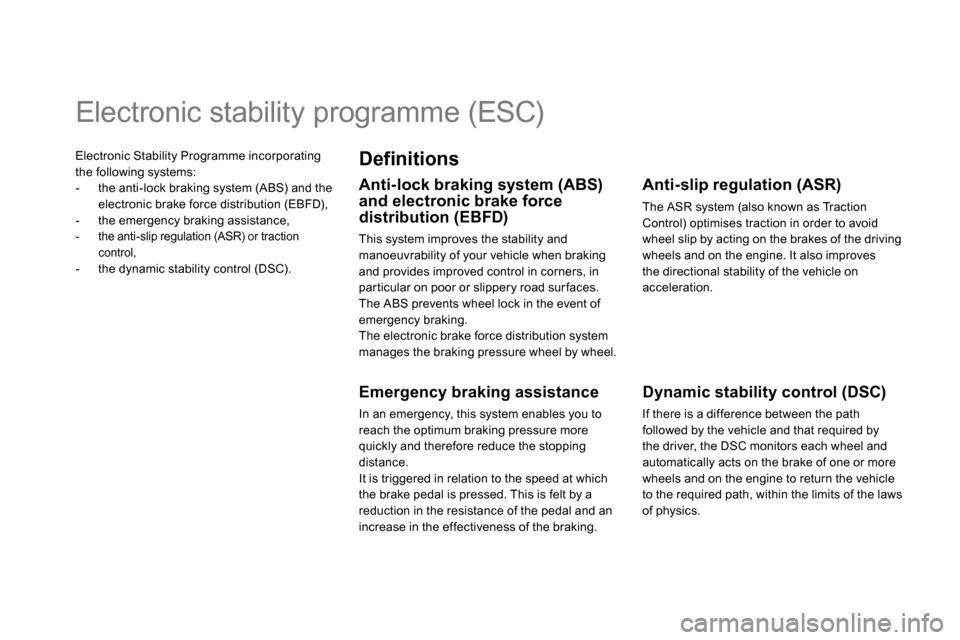
Electronic Stability Programme incorporating
the following systems:
- the anti-lock braking system (ABS) and the
electronic brake force distribution (EBFD),
- the emergency braking assistance,
- the anti-slip regulation (ASR) or traction
control,
- the dynamic stability control (DSC).
Electronic stability programme (ESC)
Definitions
Anti-lock braking system (ABS)
and electronic brake force
distribution (EBFD)
This system improves the stability and
manoeuvrability of your vehicle when braking
and provides improved control in corners, in
particular on poor or slippery road sur faces.
The ABS prevents wheel lock in the event of
emergency braking.
The electronic brake force distribution system
manages the braking pressure wheel by wheel.
Emergency braking assistance
In an emergency, this system enables you to
reach the optimum braking pressure more
quickly and therefore reduce the stopping
distance.
It is triggered in relation to the speed at which
the brake pedal is pressed. This is felt by a
reduction in the resistance of the pedal and an
increase in the effectiveness of the braking.
Anti-slip regulation (ASR)
The ASR system (also known as Traction
Control) optimises traction in order to avoid
wheel slip by acting on the brakes of the driving
wheels and on the engine. It also improves
the directional stability of the vehicle on
acceleration.
Dynamic stability control (DSC)
If there is a difference between the path
followed by the vehicle and that required by
the driver, the DSC monitors each wheel and
automatically acts on the brake of one or more
wheels and on the engine to return the vehicle
to the required path, within the limits of the laws
of physics.
Page 186 of 400

Dynamic stability control (DSC)
and anti-slip regulation (ASR)
Activation
These systems are activated automatically
each time the vehicle is started.
As soon as they detect a problem of grip or
trajectory, these systems act on the operation if
the engine and brakes.
This is indicated by flashing of this
warning lamp in the instrument panel.
Deactivation
Operating fault
Illumination of this warning lamp and
the lamp in the deactivation button,
accompanied by an audible signal
and a message, indicate a fault with
the system.
Reactivation
Press this button.
The indicator lamp in the button comes on.
The DSC and ASR systems no longer act on the
operation of the engine and on the brakes in the
event of a involuntary change of trajectory.
Press this button again.
Reactivate the systems as soon as the level of
grip permits.
Contact a CITROËN dealer or a qualified
workshop to have the system checked. In exceptional conditions (starting a vehicle
which is bogged down, stuck in snow, on soft
ground...), it may be advisable to deactivate
the DSC and ASR, so that the wheels can turn
freely and regain grip. The systems are reactivated automatically each
time the ignition is switched back on or from
30 mph (50 km/h).
Below 30 mph (50 km/h), you can reactivate
them manually:
Page 200 of 400
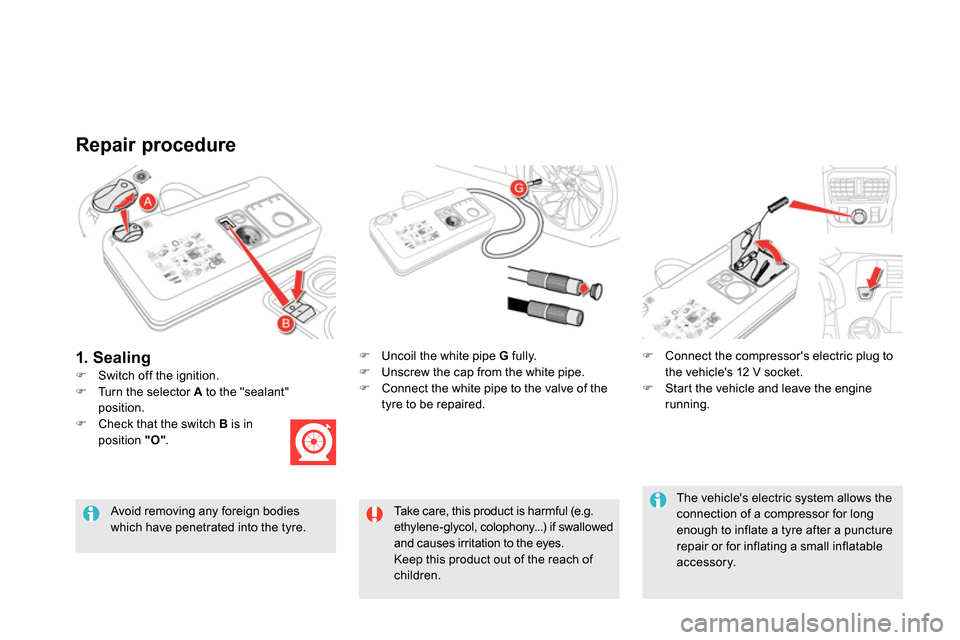
Repair procedure
Switch off the ignition.
Uncoil the white pipe G
fully.
Unscrew the cap from the white pipe.
Connect the white pipe to the valve of the
tyre to be repaired.
Connect the compressor's electric plug to
the vehicle's 12 V socket.
Start the vehicle and leave the engine
running.
Take care, this product is harmful (e.g.
ethylene-glycol, colophony...) if swallowed
and causes irritation to the eyes.
Keep this product out of the reach of
children.
Avoid removing any foreign bodies
which have penetrated into the tyre.
1. Sealing
Turn the selector A
to the "sealant"
position.
Check that the switch B
is in
position "O"
.
The vehicle's electric system allows the
connection of a compressor for long
enough to inflate a tyre after a puncture
repair or for inflating a small inflatable
accessory.
Page 202 of 400

Turn the selector A
to the
"air" position.
Uncoil the black pipe H
fully.
Connect the black pipe to the
valve of the wheel.
Connect the compressor's electric plug to
the vehicle's 12 V socket.
Start the vehicle again and leave the
engine running.
Adjust the pressure using the compressor
(to inflate: switch B
in position "I"
;
to deflate: switch B
in position "O"
and
press button C
), in accordance with the
vehicle's tyre pressure label (located on the
left hand door aperture).
A loss of pressure indicates that the
puncture has not been fully plugged;
contact a CITROËN dealer or qualified
workshop for assistance.
Remove and stow the kit.
Drive at reduced speed (50 mph [80 km/h]
max) limiting the distance travelled to
approximately 120 miles (200 km).
As soon as possible, go to a CITROËN
dealer or a qualified workshop.
You must inform the technician that you
have used this kit. After inspection, the
technician will advise you on whether
the tyre can be repaired or if it must be
replaced.
2. Infl ation
Page 203 of 400
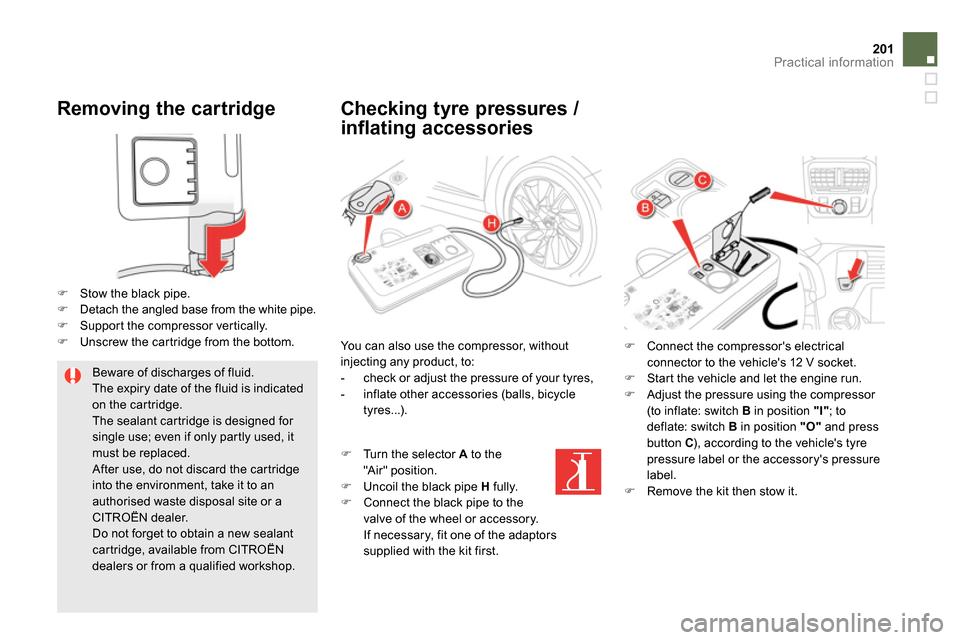
201Practical information
Removing the cartridge
Stow the black pipe.
Detach the angled base from the white pipe.
Support the compressor vertically.
Unscrew the cartridge from the bottom.
Beware of discharges of fluid.
The expiry date of the fluid is indicated
on the cartridge.
The sealant cartridge is designed for
single use; even if only partly used, it
must be replaced.
After use, do not discard the cartridge
into the environment, take it to an
authorised waste disposal site or a
CITROËN dealer.
Do not forget to obtain a new sealant
cartridge, available from CITROËN
dealers or from a qualified workshop.
Checking tyre pressures /
inflating accessories
You can also use the compressor, without
injecting any product, to:
- check or adjust the pressure of your tyres,
- inflate other accessories (balls, bicycle
tyres...).
Turn the selector A
to the
"Air" position.
Uncoil the black pipe H
fully.
Connect the black pipe to the
valve of the wheel or accessory.
If necessary, fit one of the adaptors
supplied with the kit first.
Connect the compressor's electrical
connector to the vehicle's 12 V socket.
Start the vehicle and let the engine run.
Adjust the pressure using the compressor
(to inflate: switch B
in position "I"
; to
deflate: switch B
in position "O"
and press
button C
), according to the vehicle's tyre
pressure label or the accessory's pressure
label.
Remove the kit then stow it.
Page 223 of 400
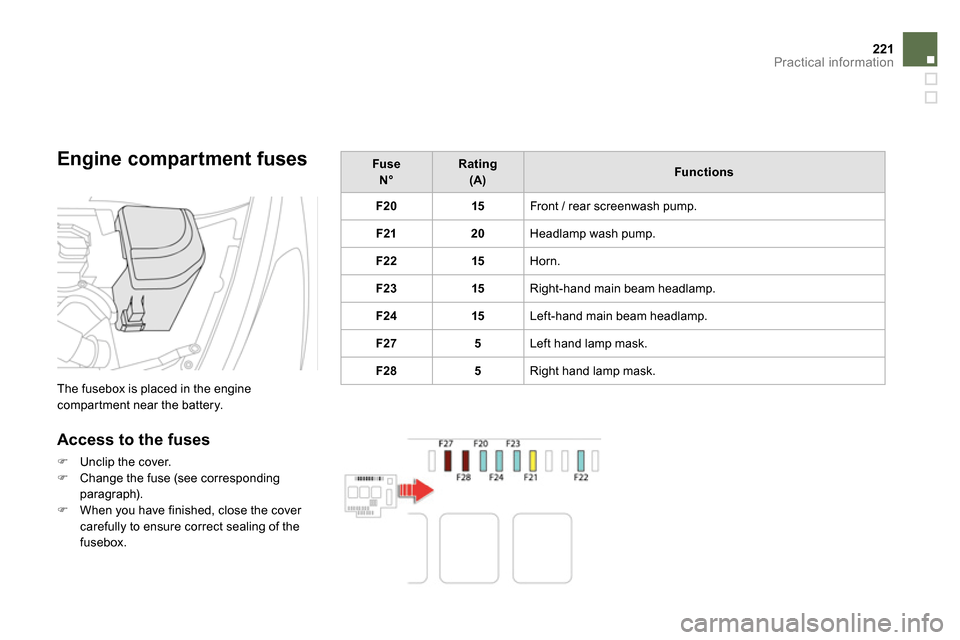
221Practical information
Engine compartment fuses
The fusebox is placed in the engine
compartment near the battery.
Access to the fuses
Unclip the cover.
Change the fuse (see corresponding
paragraph).
When you have finished, close the cover
carefully to ensure correct sealing of the
fusebox.
Fuse
N°
Rating
(A)
Functions
F20
15
Front / rear screenwash pump.
F21
20
Headlamp wash pump.
F22
15
Horn.
F23
15
Right-hand main beam headlamp.
F24
15
Left-hand main beam headlamp.
F27
5
Left hand lamp mask.
F28
5
Right hand lamp mask.
Page 224 of 400

12 V battery
The presence of this label, in particular
with the Stop & Start system, indicates
the use of a 12 V lead-acid battery with
special technology and specification;
the involvement of a CITROËN dealer
or a qualified workshop is essential
when replacing or disconnecting the
battery. The battery is located under the bonnet.
To gain access to it:
open the bonnet using the interior release
lever, then the exterior safety catch,
remove the plastic cover on
the (+) terminal,
if necessary, unclip the fusebox to remove
the battery.
Access to the battery
Disconnecting the (+) cable
Raise the locking tab D
fully to release the
cable terminal clamp E
.
Reconnecting the (+) cable
Position the open clamp E
of the cable on
the positive post (+) of the battery.
Press vertically on the clamp E
to position
it correctly on the battery.
Lock the clamp by spreading the
positioning lug and then lowering the tab D
.
Do not apply excessive force on the
tab as locking will not be possible if the
clamp is not positioned correctly; start
the procedure again.
Procedure for starting the engine using another battery or charging a discharged battery.
Page 225 of 400
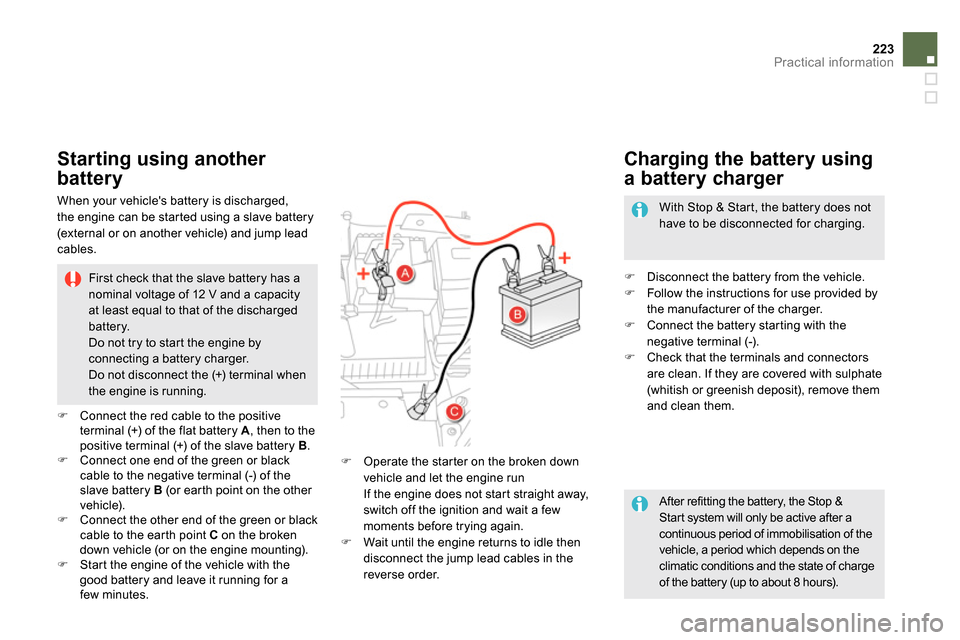
223Practical information
After refitting the battery, the Stop &
Start system will only be active after a
continuous period of immobilisation of the
vehicle, a period which depends on the
climatic conditions and the state of charge
of the battery (up to about 8 hours).
With Stop & Start, the battery does not
have to be disconnected for charging.
Starting using another
battery
First check that the slave battery has a
nominal voltage of 12 V and a capacity
at least equal to that of the discharged
battery.
Do not try to start the engine by
connecting a battery charger.
Do not disconnect the (+) terminal when
the engine is running.
Connect the red cable to the positive
terminal (+) of the flat battery A
, then to the
positive terminal (+) of the slave battery B
.
Connect one end of the green or black
cable to the negative terminal (-) of the
slave battery B
(or earth point on the other
vehicle).
Connect the other end of the green or black
cable to the earth point C
on the broken
down vehicle (or on the engine mounting).
Start the engine of the vehicle with the
good battery and leave it running for a
few minutes.
Operate the starter on the broken down
vehicle and let the engine run
If the engine does not star t straight away,
switch off the ignition and wait a few
moments before trying again.
Wait until the engine returns to idle then
disconnect the jump lead cables in the
reverse order.
Disconnect the battery from the vehicle.
Follow the instructions for use provided by
the manufacturer of the charger.
Connect the battery starting with the
negative terminal (-).
Check that the terminals and connectors
are clean. If they are covered with sulphate
(whitish or greenish deposit), remove them
and clean them.
Charging the battery using
a battery charger
When your vehicle's battery is discharged,
the engine can be started using a slave battery
(external or on another vehicle) and jump lead
cables.
Page 226 of 400

The batteries contain harmful substances
such as sulphuric acid and lead. They
must be disposed of in accordance
with regulations and must not, in any
circumstances, be discarded with household
waste.
Take used remote control batteries and
vehicle batteries to a special collection point.
It is advisable to disconnect the battery
if the vehicle is to be left unused for
more than one month.
Do not push the vehicle to start the
engine if you have an electronic or
automatic gearbox.
Protect your eyes and face before
handling the battery.
All operations on the battery must be
carried out in a well ventilated area and
away from naked flames and sources
of sparks, so as to avoid the risk of
explosion or fire.
Do not try to charge a frozen battery;
the battery must first be thawed out to
avoid the risk of explosion. If the battery
has been frozen, before charging have
it checked by a CITROËN dealer or a
qualified workshop who will check that
the internal components have not been
damaged and the casing is not cracked,
which could cause a leak of toxic and
corrosive acid.
Do not reverse the polarity and use only
a 12 V charger.
Do not disconnect the terminals while
the engine is running.
Do not charge the batteries without
disconnecting the terminals first.
Wash your hands after wards.
Before disconnecting the battery
Wait 2 minutes after switching off the ignition
before disconnecting the battery.
Close the windows and the doors before
disconnecting the battery.
Following reconnection of the
battery
Following reconnection of the battery, switch on
the ignition and wait 1 minute before starting to
permit initialisation of the electronic systems.
However, if problems remain following this
operation, contact a CITROËN dealer or a
qualified workshop.
Referring to the corresponding section,
you must yourself reinitialise (depending on
version):
- the remote control key,
- the electric blind(s),
- ...
Some functions are not available if the
battery is not sufficiently charged.
Page 227 of 400
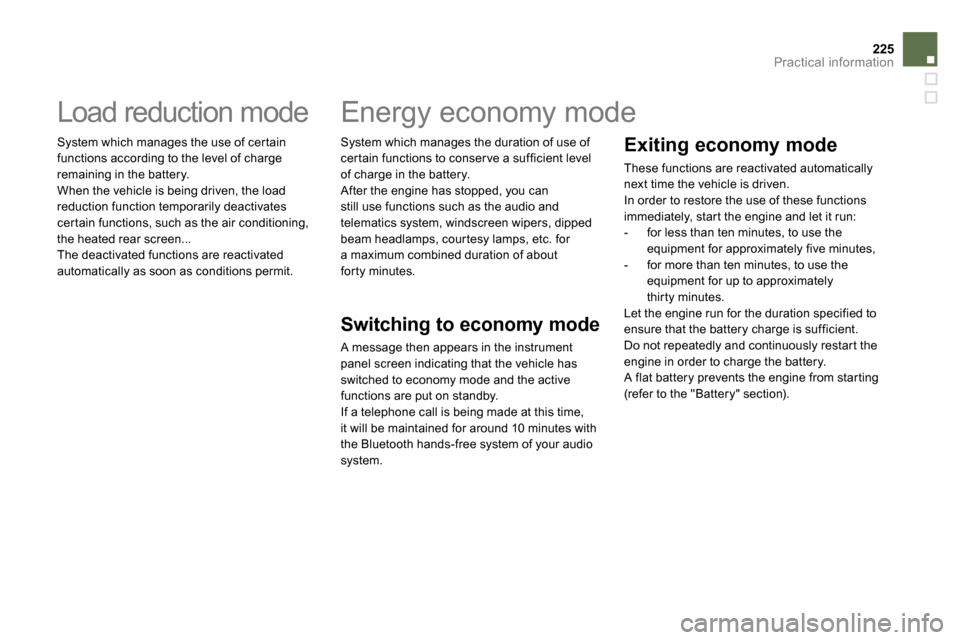
225Practical information
Load reduction mode
System which manages the use of certain
functions according to the level of charge
remaining in the battery.
When the vehicle is being driven, the load
reduction function temporarily deactivates
certain functions, such as the air conditioning,
the heated rear screen...
The deactivated functions are reactivated
automatically as soon as conditions permit.
System which manages the duration of use of
certain functions to conser ve a sufficient level
of charge in the battery.
After the engine has stopped, you can
still use functions such as the audio and
telematics system, windscreen wipers, dipped
beam headlamps, courtesy lamps, etc. for
a maximum combined duration of about
forty minutes.
Energy economy mode
Switching to economy mode
A message then appears in the instrument
panel screen indicating that the vehicle has
switched to economy mode and the active
functions are put on standby.
If a telephone call is being made at this time,
it will be maintained for around 10 minutes with
the Bluetooth hands-free system of your audio
system.
Exiting economy mode
These functions are reactivated automatically
next time the vehicle is driven.
In order to restore the use of these functions
immediately, start the engine and let it run:
- for less than ten minutes, to use the
equipment for approximately five minutes,
- for more than ten minutes, to use the
equipment for up to approximately
thirty minutes.
Let the engine run for the duration specified to
ensure that the battery charge is sufficient.
Do not repeatedly and continuously restart the
engine in order to charge the battery.
A flat battery prevents the engine from starting
(refer to the "Battery" section).